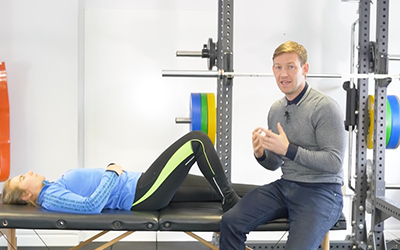Is Anterior Knee Pain Even A Diagnosis?
Posted By: Andy Barker
Once you understand this important concept (and this just does not just relate to the knee), it will make your management of problems like ‘anterior knee pain,’ ‘shoulder impingement’ and other overuse injuries much easier.
You will be able to produce quicker results in clinic and get results that actually stick, so your patients do not break down the first time they go back in the gym, go back running or back to any other activity.
After reading this blog you will realise that knee pain does NOT mean a patient needs knee rehab.
I had a patient just this week that proved this point.
He had been suffering with right knee pain during running which had meant he’d had to stop.
He’d seen a couple of therapists previously who had both treated his knee and whilst his symptoms had resolved both times in clinic, on both occasions when he returned to running his symptoms came back.
We did something different in clinic to treat his knee, without actually touching his knee at all.
We were able to take away all his symptoms in the first session and with a graded loading rehab plan I am certain he will get back to running quickly and more importantly, will stay symptom free when he returns.
So, what did we do?
A Symptom Not A Diagnosis
Before we get into his patient’s management you need to understand this…
The most important question you need to ask yourself when a patient has ANY overuse injury, like anterior knee pain, is…
Why Has The Knee [Or Something Else] Become Overloaded?
Anterior knee pain is just a symptom.
It is telling you that a patient has pain in the front of their knee.
It does not tell you what structure is causing the patient pain…
It could be the fat pad, patella tendon, patella-femoral joint or any other structure in the front of the knee.
Having a broad ‘diagnosis’ like anterior knee pain, is also not helpful for you as a therapist to direct your interventions like your hands-on treatment techniques and rehab exercises.
Generalising injury problems often means generalisation of patient management, more specifically your treatments on the bed and the rehab exercises you prescribe.
It is the reason why quad soft tissue treatments or ‘glute’ exercises for every patient with anterior knee pain does not always work.
The patient I saw in clinic that I mentioned earlier in this blog, had ‘anterior knee pain.’
But he did not have a knee problem.
His problem related to an injury on his other leg that was causing him to load his symptomatic side more, more specifically his anterior knee.
He had right patella-femoral joint pain secondary to poor left ankle mobility and stability.
What we did…
Treat The ‘Right’ Problem
Following the objective assessment all the work we did in this patient’s initial assessment session focused on his left ankle.
We did some treatment on the bed to help improve his ankle mobility, he was prescribed an ankle mobility exercise as part of his home exercise programme, then the latter part of the session we worked on his ankle stability using some hamstring and calf isometric exercise.
This took us less than 10 mins but immediately took away all his knee pain; he had pain with knee flexion, resisted knee extension and with a double and single leg squat and forward lunge.
And this was without treating his ‘knee.’
You may need to treat the knee when a patient has ‘anterior knee pain’ but you also need to identify why this part of the knee has become overloaded in the first place.
The same goes for any overuse injury.
The danger in just treating the site of pain and not identifying the source is that patients will progress well through rehab but once activity levels are increased, like when returning to the gym or running, they will quickly break down again, as their main problem has not been addressed.
Key Points
Anterior Knee Pain Means Just That – Pain In The Front Of The Knee. It Is A Symptom And NOT A Diagnosis
The Key To Treating Anterior Knee Pain (Or Other Overuse Injuries) Is To Identify Why That Area Of The Body Has Become Overloaded
Linking Your Patients Symptoms Back To Their Past Medical History To Help You Identify Their Real Problems
Just Treating The Site Of Pain & Not Identifying The Source Of Pain May Lead To A Poor Resolution To Patient Symptoms And Probable Problems For Your Patient When They Return To Higher Level Activity
PS. I go into detail about shoulder rehab in my New Grad Physio Upper Limb Course.
On this course you will discover exactly how to identify both the site AND source of symptoms, using your patient assessments to find out exactly what treatments techniques and rehab exercises your patient needs.
In addition, you will learn how to progress (and regress) any lower limb patient (including lower back pain patients) through a FULL rehab plan, start to finish, knowing when they are ready to progress to the next stage of rehab and when they are ready to be cleared for higher level activities like the gym and running.
Secure your place HERE
The course is limited to just 15 therapists due to the high amount of practical content involved.
You can find out more information about the course content HERE or if you have any specific questions let me know on andy@newgradphysio.com

